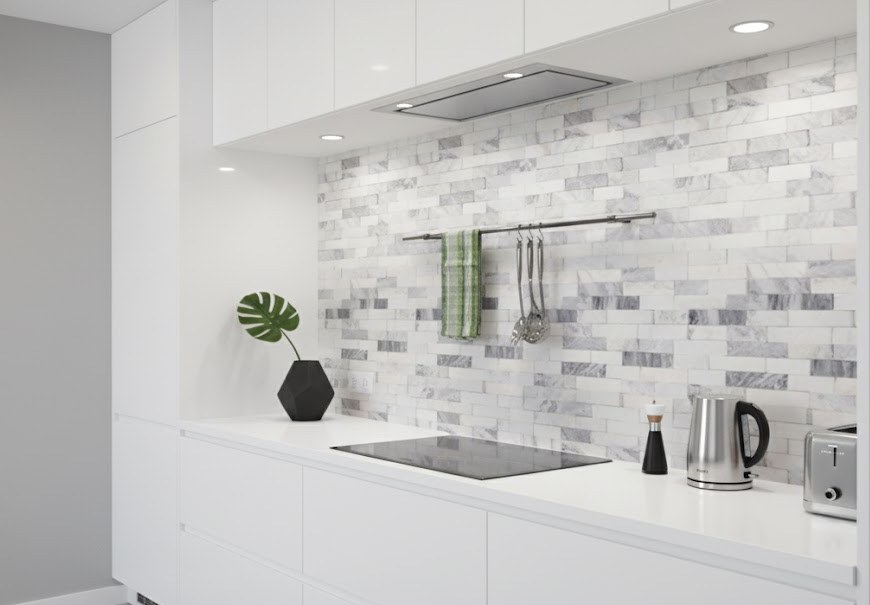Selecting a backsplash material that stands out while delivering long-term performance can be complex. This guide showcases 7 stacked stone backsplash concepts that pair organic texture with straightforward installation and proven durability. You’ll discover options from rugged slate to refined quartzite, see how to implement full-wall statements or backlit features, and gain actionable tips on sealing, upkeep, and choosing materials to align both visual impact and practical demands.
More Than Just Tile: Why Go With a Stacked Stone Backsplash?
For procurement managers, designers, and contractors seeking standout options beyond conventional ceramic or porcelain tiles, stacked stone backsplashes deliver clear design and commercial advantages. Their dimensional surfaces, adaptability, and durability make them viable for both high-end residential and performance-demanding commercial installations. Below, we outline the factors that can strengthen bids and improve project results when specifying stacked stone.
Visual Impact and Unique Aesthetic Appeal
Stacked stone adds depth, texture, and natural movement to a backsplash. As light shifts across its uneven layers, the surface becomes dynamic rather than static. Each panel’s distinct tone, veining, and relief ensures no two projects look the same. This uniqueness creates a high-value signature element that mass-produced tiles cannot match, making it easier to secure contracts where clients demand distinction and a premium finish. On high-value builds, that kind of visual identity can win decisions.
Versatility Across Design Styles and Project Needs
Estos panels work across diverse aesthetics—from the clean lines of modern kitchens to the warmth of rustic retreats. Stone types, color palettes, and cut styles can be tailored to project-specific concepts without sacrificing design intent. For B2B buyers, this flexibility streamlines procurement because a single supplier can fulfill varied briefs, saving time and consolidating orders.
Sustainability and Eco-Friendly Material Options
Most stacked stone is quarried from natural slate, quartzite, marble, or limestone—materials that contribute to green building goals and help earn eco-project points. In markets where environmental performance shapes purchasing decisions, being able to specify a backsplash that aligns with sustainability targets strengthens tender submissions and ESG reporting.
Installation Efficiency and Cost Benefits
Modular panels install faster than traditional stonework, cutting labor costs and timelines. Interlocking edges eliminate visible grout lines, enhancing appearance and removing extra steps. With weights generally between 8 and 13 pounds per square foot, panels are easier to handle and impose minimal structural load, supporting faster turnovers on tight schedules.
Durability, Maintenance, and Long-Term Value
Natural stacked stone withstands heavy use in high-traffic commercial kitchens and busy homes. It resists UV fading and requires minimal upkeep, retaining its look for decades without recurring maintenance costs. For contractors and distributors, that means fewer callbacks—key to protecting margins and client relationships.
Key Considerations for B2B Recommendations
When advising clients, underscore the tactile and visual distinction over standard tile, the adaptability to varied design schemes, and the breadth of stone options for customization. Highlight labor savings from the modular system and the extended service life that safeguards investment value. Together, these advantages position stacked stone backsplashes as a high-return choice that delivers design impact and operational efficiency.
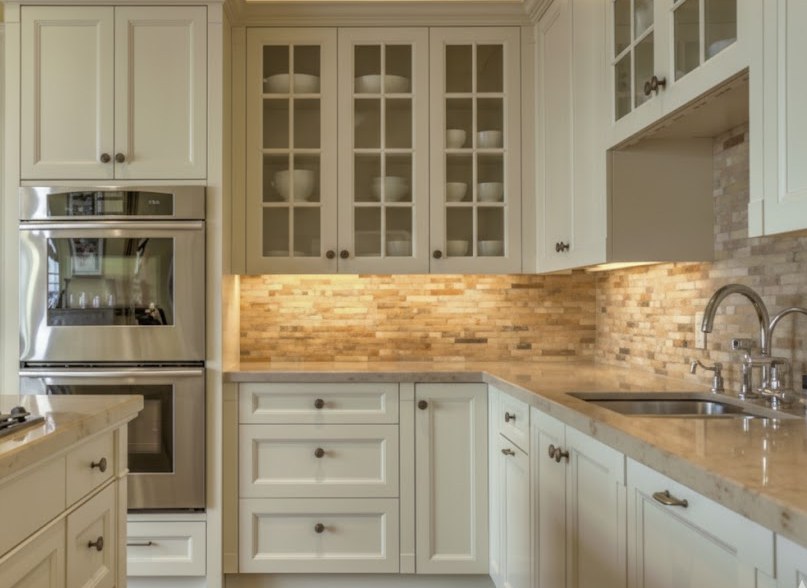
The Pro Tip You Can’t Ignore: Sealing, Cleaning, and Grease
In high-traffic commercial and premium residential kitchens, moisture, grease, and stains can quickly compromise a stacked stone backsplash. Prioritize sealing, disciplined cleaning, and proactive grease control from installation to preserve both aesthetics and performance—and avoid unnecessary restoration spend.
The Importance of Sealing Stacked Stone
Natural stacked stone’s porosity demands protection. Apply a high-quality, stone-specific sealer during the fit-out and reapply at least once a year to block moisture and grease penetration. Treat grout lines with a grout-specific sealer containing mildewcide to maintain hygiene and simplify cleaning; neglecting this step often leads to mold, staining, and costly remediation.
Best Practices for Cleaning
Use pH-neutral or stone-safe cleaners to prevent etching or fading; avoid acidic, citrus-based, or bleach solutions. For daily upkeep, remove food particles and grease with a stiff-bristled, non-abrasive brush, then rinse with warm water to prevent detergent buildup. Skip high-pressure washing or abrasive tools—they can damage surface texture and amplify defects.
Managing Grease and Stains Effectively
Address grease splatters immediately with mild detergent and water to prevent deep stains. For set-in grease, apply a heavy-duty stone-safe degreaser after spot-testing. When damage surpasses routine cleaning, engage professional stone restoration to recover uniform appearance and extend service life; ignoring severe damage often forces full panel replacement, disrupting budgets and timelines.
Idea 1: The Rustic Farmhouse Look (Warm Slate & Travertine)
For B2B buyers targeting stacked stone backsplashes, the rustic farmhouse style is a proven strategy for creating a warm, lived‑in atmosphere that appeals to residential clients. Selecting warm slate and travertine blends timeless appeal with durability, generating consistent opportunities across renovation and new build projects. Aligning material authenticity with efficient installation and strong end‑user satisfaction directly strengthens project value and margin potential.
Key Features of the Rustic Farmhouse Style
This look thrives on tactile authenticity, with natural textures and earthy tones making kitchens feel inviting. Traditional detailing balanced with modern elements broadens market reach, attracting both homeowners seeking classic charm and those preferring a contemporary edge with rustic character. Core materials such as piedra natural, aged wood, and occasional brick accents create differentiation from mass‑produced alternatives. Warm slate and travertine expand this palette, pairing easily with shaker cabinetry, open shelving, or vintage‑style fixtures, while maintaining visual richness over time to mitigate aesthetic obsolescence.
Materials and Texture Considerations
Warm slate’s tonal variation and split‑faced edges produce depth and shadow that convey a handcrafted quality, even in small backsplash runs—ideal for showroom presentations that encourage tactile engagement. Travertine complements with a smooth yet organically detailed surface, adding elegance without losing rustic appeal. For kitchen applications, source stone lots with consistent structural integrity and specify durable finishes to avoid staining or wear. With proper sealing, both stones retain their appearance through routine cleaning—an essential benefit for installers and end users prioritizing low‑maintenance beauty.
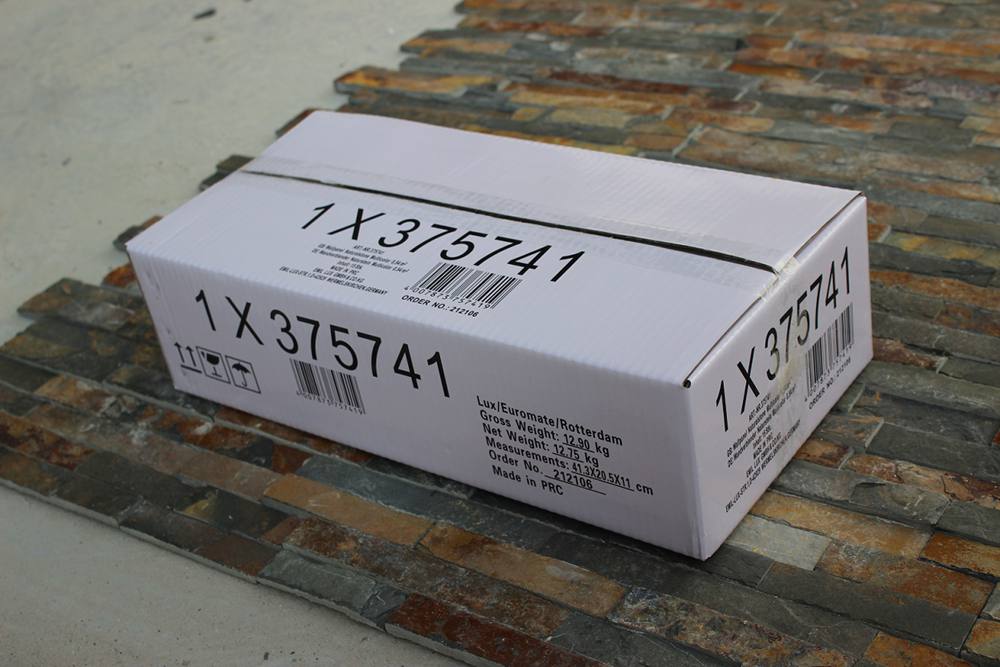
Market and Customization Trends for B2B Buyers
Demand includes both traditional stone installations and peel‑and‑stick formats for quick updates. Offering both widens appeal to contractors with varying capabilities and timelines. Customization is gaining traction—distributors supplying multiple patterns, finishes, and calibrated colorways meet more bid specifications and design briefs. Coordinating color and texture with cabinetry and flooring fast‑tracks approvals. Proactive suppliers track trending cabinet stains and countertop materials to recommend combinations instantly, positioning themselves as trusted design partners.
Durability and Practical Benefits
Warm slate and travertine deliver long‑term performance, resisting fading from sunlight or ambient lighting and reducing the risk of warranty claims tied to discoloration. Their durability supports confident specification for kitchens with substantial natural light exposure. Maintenance remains simple—periodic sealing prevents staining, and daily cleaning requires only mild agents. Beyond functionality, these materials contribute to the approachable aesthetic that defines the farmhouse kitchen, strengthening emotional appeal, resale potential, and overall project profitability for B2B clients.
Enhance Your Projects with Authentic Ledger Stone
Add timeless natural texture and versatile design to your builds. Our interlocking ledger stone offers efficient installation, lasting durability, and premium craftsmanship designed to inspire architects, contractors, and distributors alike.

Idea 2: The Modern Sparkle (Polished Quartzite)
Polished quartzite combines refined aesthetics with robust performance, making it a strategic option for stacked stone backsplashes that demand a modern edge. It is one of the few materials that meets high-end residential taste while satisfying rigorous B2B procurement standards. Its clarity of color, surface brilliance, and long-term resilience allow distributors and designers to position a truly premium product without creating maintenance burdens.
Luxurious Appearance and Modern Aesthetic
The reflective surface of polished quartzite elevates the kitchen environment, capturing light and adding a subtle sparkle that defines focal points. Varieties like Taj Mahal, Cristallo, and Fantasy Montreal offer neutral white or gray bases with distinctive veining, ranging from soft to dramatic depending on the design vision. This versatility enables precise alignment with client preferences while retaining a contemporary profile. For B2B buyers, the polished finish boosts perceived installation value and supports premium-tier positioning, reducing the need for supplementary materials and streamlining project coordination.
Durability and Practical Benefits for Kitchens
Quartzite’s natural scratch resistance keeps backsplash panels looking pristine under daily use—a benefit for homeowners and contractors seeking to avoid post-installation service calls. The polished surface cleans easily with mild solutions, minimizing labor during installation and after-sales support. Its UV resistance preserves color integrity in sunlit spaces over time. For B2B operations, that longevity strengthens product reputation and lowers warranty risk, making it a reliable choice for volume projects.
Key Considerations for B2B Sourcing and Installation
For large runs, secure slabs with consistent coloration to avoid mismatched tones that disrupt a continuous look, especially when panels align on the same wall. Work only with suppliers who apply precise polishing for a uniform gloss that reinforces luxury positioning. Before committing to full-height formats, clarify handling requirements—large, polished pieces demand proper support and exact alignment to prevent stress points or visible seams. Addressing these factors upfront simplifies installation and safeguards both structural integrity and the high-end finish your clients expect.
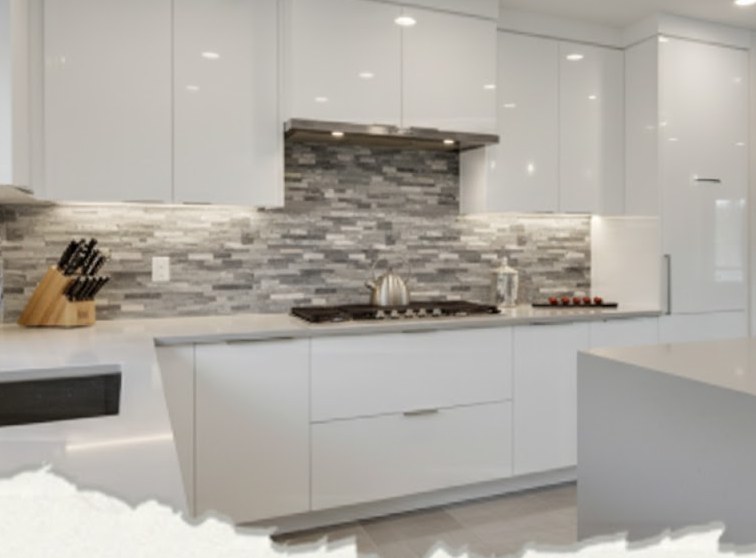
Idea 3: The Industrial Vibe (Dark, Split-Face Slate)
For B2B kitchen projects seeking a definitive industrial edge, dark split-face slate offers both visual authority and operational gains. Its dimensional texture, dense composition, and proven longevity let procurement teams lower lifecycle costs while satisfying brand and client expectations for a bold, modern finish.
Material and Performance Benefits of Dark Split-Face Slate
Split-face slate stacked stone delivers immediate depth and tactile appeal, strengthening the industrial style without synthetic substitutes. Its rugged surface shifts visually with changing light, creating a dynamic commercial backdrop. Naturally dense and low porosity, it resists water and stains—critical in food prep zones where speed and hygiene drive decisions. The irregular texture conceals scuffs and chips, extending visual freshness between maintenance cycles, while heat resistance enables safe installation near cooking areas in hospitality and high-use residential environments.
Installation Methods and Cost Considerations
Modular panels accelerate installation compared to full-depth stone, supporting tighter timelines and multi-site rollouts that directly improve margins. Lighter weight reduces structural reinforcement needs, increasing placement flexibility. Matching corner and trim pieces streamline a continuous, polished finish without complex cuts. Standardized module sizing minimizes waste and keeps workflows consistent across crews, whether internal teams or subcontractors.
Design Strategies for Industrial-Themed Kitchens
Full-height dark slate backsplashes can define a kitchen’s visual anchor, especially behind ranges or statement hoods. For balance, pair accent walls with neutral surfaces to temper intensity. Exposed brick, brushed steel, and poured concrete complement split-face textures for a cohesive commercial-grade look. In branded spaces like coffee shops, bars, or open kitchens, dark tones can highlight logos, menu boards, and lighting. Developers can standardize these elements across multi-unit or franchise projects to maintain consistent brand identity.
Sourcing and Product Specification Options
Top suppliers offer dark split-face slate in multiple module formats to fit varying wall heights. Factor in matching trims and corners at order stage to avoid mismatched later additions. For non-standard dimensions, request custom sizing early so production and delivery align with build schedules. Select suppliers providing consistent coloration and finish, and secure material from a single quarry lot to prevent shade variation—essential for large continuous installations meeting operational needs and visual standards of industrial kitchen concepts.

Idea 4: The Bright & Airy Look (Light Marble)
Light marble stacked stone backsplashes deliver a refined, spacious feel with tangible B2B benefits. Soft tones and natural patterns create client appeal while the right format, design approach, and functional features can accelerate installation timelines and strengthen long-term value in procurement decisions.
Material Formats and Sourcing Options
Available in slab or tile formats, light marble adapts to diverse projects. Slabs provide a seamless, polished surface with minimal grout, ideal for high-end or expansive kitchens. Tiles offer layout flexibility and simpler handling for compressed schedules. Partnering with suppliers who customize sizes and cuts enables precise fits for unique dimensions, serving both compact urban spaces and large open layouts without disrupting supply chains.
Design Techniques for Maximizing Brightness and Space
Crisp white or pale gray marble enhances light reflection, helping rooms feel larger. Pairing white marble with matching cabinetry creates a calm, continuous aesthetic, while deep-toned cabinets introduce contrast and a defined focal point. For added visual texture, leaf-shaped or geometric mosaics break flat planes and inject subtle movement, preventing overly sterile finishes.
Functional and Maintenance Advantages
Marble’s heat resistance protects backsplash zones in cook-intensive settings. Its reflective surface boosts lighting while disguising minor wear, keeping display kitchens market-ready longer. Routine cleaning with stone-safe products preserves the upscale finish for years, reducing maintenance labor and cost.
B2B Marketing and Specification Strategies
Light marble’s cross-style appeal allows distributors to position it for both classic and modern projects. Emphasize key advantages: minimal upkeep, compatibility with premium finishes such as brass or copper, and flexibility in slabs or tiles. For specifiers, highlight how it improves resale potential and elevates perceived quality, aligning with investment strategies that balance upfront spend against enduring return.
Idea 5: The “Full-Wall” Statement (Floor to Ceiling)
Extending a stacked stone backsplash from floor to ceiling elevates it from background detail to a bold architectural signature. For B2B buyers, it delivers high-impact visuals, appeals to premium clientele, and highlights craftsmanship without complex structural changes. Coordinating design, procurement, and installation teams from the outset ensures the intended aesthetic is executed flawlessly.
Design Benefits of Full-Wall Stone Backsplashes
Running stone uninterrupted from floor to ceiling expands perceived space and visual unity. Eliminating breaks from cabinetry or trim makes the stone the focal point, with its depth and texture resonating strongly in both residential showrooms and hospitality environments. It transforms a practical surface into a high-value design statement.
Choosing Materials for Full-Wall Applications
Select durable materials with distinctive visual character—marble, limestone, travertine, and slate each offer unique palettes and patterns. Match the selection to wear conditions: commercial kitchens require higher resistance, boutique spaces may prioritize rare coloration. Large slabs or oversized tiles reduce grout lines, enhancing seamlessness and minimizing upkeep.
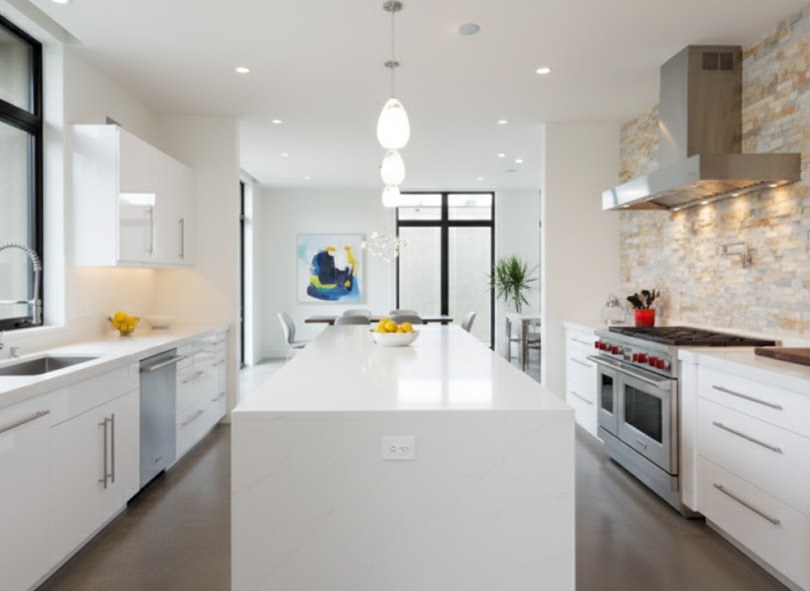
Installation Challenges and Best Practices
Full-wall stone demands precise execution. Heavy panels or vein-matched slabs require experienced crews and the right equipment. Confirm logistics early to allow for extra handling time and accurate fitting, especially for directional veining. Prep substrates fully and address corners before main installation to avoid costly misalignments and schedule overruns.
Integrating Lighting and Adjacent Finishes
Treat lighting as part of the stone specification. Wall washing or integrated under-cabinet lighting can enhance depth without overpowering the design. Minimalist cabinetry keeps sightlines clean, while complementary countertop and floor finishes prevent visual competition, preserving the wall’s impact.
Supplier Selection and Long-Term Considerations
Partner with suppliers experienced in full-wall projects who can provide technical insights, custom sizing, and batch-matched sourcing. Request sustainability documentation and clarify maintenance requirements upfront. Dependable partners align production and shipping with your timelines, ensure uniformity across the wall, and safeguard your firm’s reputation.
Idea 6: The “Wet Bar” Accent (Perfect for Small Spaces)
Small-space wet bars demand smart design and durable finishes to maximize utility and appeal. Strategic use of stacked stone backsplashes creates a focal point while delivering a robust, easy-to-maintain surface—ideal for designers, contractors, and resellers seeking to elevate compact entertaining zones. To add value, focus on modular components and adaptable styles suited for residential or boutique hospitality projects, ensuring every inch delivers performance and visual impact.
Space-Saving Wet Bar Layouts
In tight floorplans, position the wet bar in a corner or along a single wall to maintain clear circulation and full functionality. Built-in cabinetry should integrate seamlessly with surrounding finishes to reduce visual clutter and enhance the sense of space. Maximize vertical capacity with floating shelves or tall units for storing glassware, spirits, and tools, and specify multi-purpose pieces like bar carts with hidden compartments for flexible event hosting.
Material and Finish Selection with Focus on Stacked Stone
Stacked stone lends depth without overpowering small wet bars, turning an accent wall into a crafted focal point that downplays size constraints. Choose lighter-tone slate or quartzite to boost light and perceived space, and pair stone with quartz counters for low-maintenance cleaning, marble for premium appeal, or metallic trims for modern contrast. Prioritize finishes that resist stains and clean easily to preserve style and minimize upkeep in busy hospitality environments.
Lighting and Technology Integration
Use under-shelf or under-cabinet LEDs to create an inviting glow and improve visibility, and highlight stone textures with directional pendant lighting for drama and depth. Fit compact smart appliances—mini fridges, wine coolers—under counters to maintain storage capacity. Pre-wire for integrated speakers or discreet displays during installation to deliver turnkey B2B solutions without post-construction disruption.
Customization and B2B Opportunities
Open shelving or glass-front cabinetry allows clients to showcase curated drinkware, transforming the wet bar into a visual feature. Contemporary matte black or brushed metal hardware reinforces a premium look. For distributors and installers, offering modular wet bar kits and customizable stacked stone panels speeds client decisions and boosts upsell potential. Bundling installation support with tailored lighting plans ensures even small-scale projects meet high design and performance standards, strengthening repeat business.
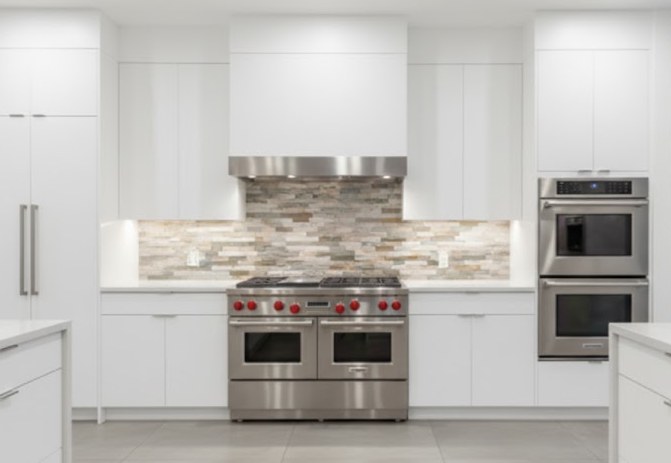
Idea 7: The “Backlit” Glow (Using Undercabinet Lighting)
Strategically positioned undercabinet lighting can elevate the impact of a stacked stone backsplash in any kitchen build. For B2B designers, contractors, and distributors, this is a value-driving upgrade that enhances natural depth, supports premium positioning, and differentiates bids in competitive markets.
Visual Impact of Undercabinet Lighting on Stacked Stone Backsplashes
Light sources mounted under cabinets project a warm or cool glow that amplifies the stone’s color variations and texture. This effect is especially striking with Rough or Pencil Series panels, where light catches on uneven surfaces to create high-relief contrast and depth that flat tile cannot match. In client presentations, this transformation shifts the backsplash from background detail to the centerpiece, boosting perceived value and strengthening negotiation leverage with upscale buyers.
Key Design Considerations for B2B Professionals
Select fixtures with adjustable brightness so end-users can set the tone for cooking, dining, or entertaining — a strong selling point in high-end markets. Specify beam angles that deliver consistent coverage across the backsplash to avoid hotspots or dark zones. Position lights far enough forward under the cabinet lip for even wash without glare, and integrate intuitive controls to add sophistication and ease during client handover.
Complementary Design Elements to Enhance the Lighting Effect
Coordinate hardware finishes with light temperature — brushed nickel pairs well with cool LEDs, while warm bronze aligns with warmer tones. Plan electrical strip and outlet locations in early design to keep them out of sightlines. This ensures a clean visual, photographs better for marketing, and reinforces attention to detail that secures premium positioning and protects margins.
The Final Verdict: Is It a Practical Choice for Your Kitchen?
When deciding if stacked stone backsplashes fit your kitchen project, weigh design impact against installation efficiency and lifecycle performance. The right selection should elevate the space without adding unnecessary build complexity or maintenance overhead. Stacked stone delivers authentic texture and depth with unique piece-to-piece variation, creating a bespoke, high-value finish that stands out in premium builds or competitive resale markets.
Thanks to lighter weight and interlocking profiles, panels install quickly without structural reinforcement, helping contractors compress timelines and protect labor budgets—critical when margins are tight. The durable surface resists UV fading, retains its look for years, and needs little upkeep, though sealing in high-use areas is recommended for stain and moisture defense. Their adaptability suits modern, rustic, or transitional designs, giving stakeholders a versatile, enduring material choice that adds both immediate character and long-term value.
Frequently Asked Questions About Stone Backsplashes
These FAQs address the practical considerations contractors and homeowners weigh when planning or maintaining a stacked stone backsplash, focusing on installation, care, and long-term value based on proven project outcomes.
Is It Hard to Clean Behind a Stove?
Textured stone readily traps grease and dust, especially in tight gaps behind appliances. Design for easy access—allow clearance or use removable panels. For upkeep, a soft brush with mild detergent removes buildup without damaging the finish, keeping the backsplash sharp and low-maintenance.
Do You Have to Seal a Stone Backsplash?
Natural stone is porous and will absorb stains if left unsealed. Apply a professional-grade stone sealant immediately after installation, and in high-use kitchens, reseal every 2 years to maintain protection and simplify cleanup. Skipping sealing can lead to permanent discoloration even specialist cleaning cannot correct.
Can I Install It Myself?
Interlocking stone panels make DIY possible, but success depends on proper substrate prep and adhesive application. Corners and uneven walls require precise handling to keep joints tight and lines true. Skilled homeowners can produce strong results, yet hiring a professional eliminates guesswork and limits costly setbacks.
How Does the Cost Compare to Tile?
Stacked stone typically carries higher upfront costs than ceramic or porcelain tile, due to premium materials and more labor-intensive installation. The added expense buys a natural aesthetic, extended lifespan, and potential property value gains that standard tile often cannot match.
Is It a Timeless Look?
Natural stone’s depth and texture complement both contemporary and classic kitchen designs, delivering a look that outlasts short-term trends. Its authentic character reinforces perceptions of quality and design integrity, often enhancing resale appeal with discerning buyers.
Final Take on Choosing Stacked Stone Backsplashes
Stacked stone backsplashes deliver a blend of natural texture, color variation, and adaptable styling that adds enduring visual impact in professional kitchen projects. Modular, interlocking panels accelerate installation and limit structural demands, helping control labor costs without compromising quality. With proper sealing, they resist stains, moisture, and UV fading—ensuring long-term performance. Align stone type and finish with design and durability goals, and partner with suppliers who guarantee consistent color and precision cuts to maximize return on investment.

